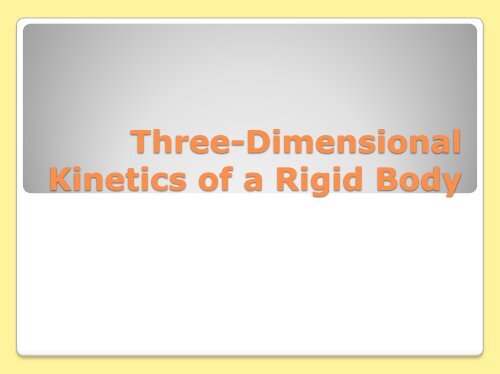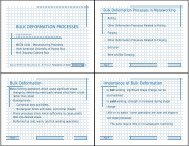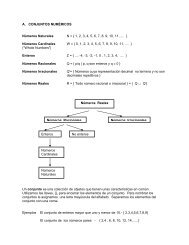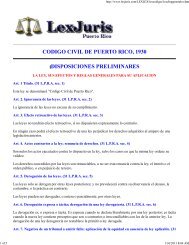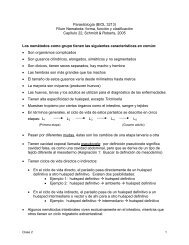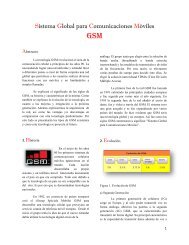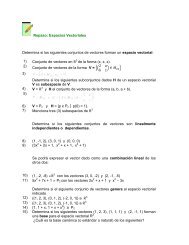Moments and Products of Inertia
Moments and Products of Inertia
Moments and Products of Inertia
You also want an ePaper? Increase the reach of your titles
YUMPU automatically turns print PDFs into web optimized ePapers that Google loves.
Three-DimensionalKinetics <strong>of</strong> a Rigid Body
<strong>Moments</strong> <strong>and</strong> <strong>Products</strong> <strong>of</strong> <strong>Inertia</strong>• Moment <strong>of</strong> <strong>Inertia</strong>dmzydmrdIxxx222mmzzzmmyyymmxxxdmyxdmrIdmzxdmrIdmzydmrI222222222
• Product <strong>of</strong> <strong>Inertia</strong>dI xy xydmIxyIyxmxydmIyzIzymyzdmIxzIzxmxzdm<strong>Moments</strong> <strong>and</strong> <strong>Products</strong> <strong>of</strong> <strong>Inertia</strong>
• Parallel-Axis TheoremIIIxxyyzz 2 2Ix'x' m yG zG 2 2Iy'y' m xG zG 2 2I m x y z'z'GG<strong>Moments</strong> <strong>and</strong> <strong>Products</strong> <strong>of</strong> <strong>Inertia</strong>
• Parallel-Planes TheoremIIIxyyzzxIIx'y'y'z'GGIz'x' mzGxGGmxmyGGyzGG<strong>Moments</strong> <strong>and</strong> <strong>Products</strong> <strong>of</strong> <strong>Inertia</strong>
• <strong>Inertia</strong> Tensor◦ The inertialproperties <strong>of</strong> abody are thereforecompletelycharacterized bynine terms, II IxxyxzxIx00 IIIyyI0y0xyzy00IzIIIzzxzyz<strong>Moments</strong> <strong>and</strong> <strong>Products</strong> <strong>of</strong> <strong>Inertia</strong>
H A vH A Amiviivi vA H mv AiAiAAm ivA A Ami dm dmAm A mA AAAAngular Momentum
• Fixed Point OH0 m00dmAngular Momentum
• Center <strong>of</strong> Mass GH G m G GdmAngular Momentum
• Arbitrary Point AHA G /AmvGHGAngular Momentum
• Rectangular Components <strong>of</strong> HHxiH0 m0 dmH0 mH G dm H j H k yzm Gm Gdmxi yj zki j kxi yj zkxyzdmAngular Momentum
• Rectangular Components <strong>of</strong> HHHHxyz Ixx I I Ixyxzxxxxy I I Iyyzyyyyxz I IyzzzzzzIf x, y, z become principalaxes <strong>of</strong> inertia,Angular MomentumHHHxyzIIIxyzxzy
• Principle <strong>of</strong> Impulse <strong>and</strong> MomentumMay be used to solve problems which involve force, velocity<strong>and</strong> timemt 1v GFdt m v1G 2t2 tH OM1Odt HO2t12Six scalar equations can be written: three relate the linearimpulse momentum in the x, y, z directions <strong>and</strong> the otherthree relate the body’s angular impulse <strong>and</strong> momentumabout the x, y, z axesAngular Momentum
TTii12m 2 1 1m 2 iv i2m iv ivii1212vi vA vA AvA A vA vAmi vAAmi AAmiAT v v dm1 m v2 A 12A A m A Admm AKinetic Energy
• Fixed Point OT 1 H20T12Ix2x12Iy2y12Iz2zKinetic Energy
• Center <strong>of</strong> MassT12mv2GT121 mv H G2Ix2x1212Iy02y12Iz2zKinetic Energy
• Principle <strong>of</strong> Work <strong>and</strong> EnergyHaving the formulated the kinetic energy for a body, theprinciple may be used to solve problems which involve force,velocity <strong>and</strong> displacement T U T1 1 2 2Kinetic Energy
• Equations <strong>of</strong> Translational MotionF ma GF ma x G xFy m aGy F z m aGzEquations <strong>of</strong> Motion
• Equations <strong>of</strong> Rotational MotionM H rr i / Gmiai / G miriGaGHG/FEquations <strong>of</strong> Motion i i / GiviGmG /0Hi ri / Gm ivi/ G ri/ Gmivi / G0GHH i ri/ GiaiGGGm /rOH Oai / Gmi i / GM H G G
• Equations <strong>of</strong> Rotational MotionMMOGHO HOxyzHG HGxyzEquations <strong>of</strong> Motion
• x, y, z Axes Having Motion Ω=0MMOH OGH G xyz xyzEquations <strong>of</strong> MotionThe axes may be chosen withorigin at G , such the axes onlytranslate relative to X, Y, ZThe body may have a rotation ω about these axes, <strong>and</strong> therefore themoments <strong>and</strong> products <strong>of</strong> inertia <strong>of</strong> the body would have to be expressedas function <strong>of</strong> time
• x, y, z Axes Having Motion Ω=ωMMOGHOHOxyzHGHGxyzThe axes may be chosen suchthey are fixed in <strong>and</strong> move withthe bodyThe moments <strong>and</strong> products <strong>of</strong> inertia <strong>of</strong> the body relative to these axeswill be constant during the motionEquations <strong>of</strong> Motion
• x, y, z Axes Having Motion Ω=ωExpressing the previous vector equations as three scalarequations; M I Mxy I ....The axes are chosen as principalaxes <strong>of</strong> inertia, the product <strong>of</strong>inertia are zerox Iyy Izz yz I xyyzx2 2yzIzx zxy Mz ....Equations <strong>of</strong> MotionxxyxMMMxyzIII xyzx zy IIyzIIzIx Iy x yx y z zx
• x, y, z Axes Having Motion Ω≠ωTo simplify the calculations for the time derivative <strong>of</strong> ω, is convenientto choose the x, y, z axes having an angular velocity Ω which isdifferent from the angular velocity <strong>of</strong> the bodyMMMxyzIII xyzx zy IIIyxzzxyyzxIIIzxyyzxzxyEquations <strong>of</strong> Motion


